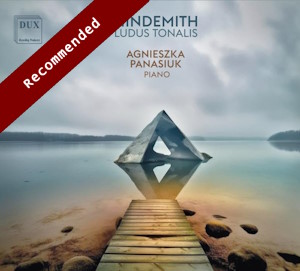
Paul Hindemith (1895-1963)
Ludus Tonalis (1942)
Agnieszka Panasiuk (piano)
rec. 2022, Feliks Nowowiejski Warmia and Masuria Philharmonic concert hall, Olsztyn, Poland
DUX 1904 [59]
Towards the middle of the last century two composers, one French and one German, each wrote a treatise on their musical language and then each followed this up with an extended piano work which demonstrated their ideas in action. The French composer was Messiaen, and the work his Vingt Regards sur l’Enfant-Jésus; the German composer was Hindemith, and his work was this one here, Ludus Tonalis, which means, roughly, play of notes. Messiaen’s work took some time to get established but is now accepted as a piano classic and is frequently performed and recorded. Hindemith’s work was an immediate success, with the first edition of the score promptly selling out. However, it has remained something of a connoisseur’s work, though there has been a fair number of recordings.
The work might at first be considered forbidding. It is a set of twelve three-part fugues, interspersed with interludes. There is an opening Praeludium and a concluding Postludium, and the latter is the retrograde inversion of the former, a kind of bow to Schoenberg, who habitually used such devices. However, otherwise the principal influence is that of Bach, and Hindemith was consciously writing a successor to Bach’s two books of twentyfour Preludes and Fugues. However, there are also other influences. The opening Praeludium, for example, owes a good deal to the opening of Busoni’s Fantasia Contrappuntistica, another massive example of twentieth century contrapuntal mastery. Otherwise, these echoes are most evident in the Interludes. Interludes 8 and 9 owe something to two of Bach’s Goldberg Variations as does Interlude 10 to the fugue in Beethoven’s Diabelli set. Later composers are also sometimes evoked, such as Ravel – the Rigaudon from Le Tombeau de Couperin – in Interlude 3, and Prokofiev’s way of poking fun at pomposity in Interlude 6. In contrast, the fugues themselves tend to be more inward-looking and are often very quiet. The rumbustious Fugue 4 is an exception, although this has a Schumannesque middle section.
However, this account does not convey the variety and interest of the work. There is wit, virtuosity and light-hearted play as well as contrapuntal devices and ingenuity. It is, however, tricky to play, with frequent wide stretches, complex writing and some massive climaxes.
Since it is not one of those works which every pianist thinks they must play, those who do so tend to be enthusiasts, and their performances committed and expressive. Such is the case here. Agnieszka Panasiuk is Polish, though she has also worked a good deal in Iceland and has been active in the chamber music scene. I greatly enjoyed her performance. One way in which her performance differs from others I have heard is that she is rather more generous with the sustaining pedal, which brings out the harmonies more clearly. This is particularly evident in the Praeludium and Postludium and some of the slower fugues. She fully grasps the wit in the work, as for example in the Interlude between Fugues 3 and 4 and the dance-like Fugues 5 and 9. The Interlude between Fugues 7 and 8 is suitably massive, like Mussorgsky’s ox cart in Pictures at an Exhibition. But much of the work is quiet and meditative and in these movements she offers a gentle eloquence which is very attractive.
The recording is good, though a little close. And there is a pleasant surprise. After the end of the work, I heard the unmistakeable strains of Bach, to be precise the Sarabande from the second French Suite. I haven’t listed this above, as it is obviously an encore, and a very welcome one too. I hadn’t expected it because the track listing is on the last page of the booklet, which itself fits inside the folder containing the disc and so has to be taken out to see.
This is an admirable account. Of other recordings I should pick out that by Käbi Laretei, as she studied the work with the composer and gives an authoritative account, which was long a collectors’ item until it finally appeared on CD a few years ago (review). I don’t believe that there is such a thing as a definitive performance, and others, such as that by Berezovsky are also worth hearing. I am happy to commend Panasiuk’s performance along with these.
Stephen Barber
Help us financially by purchasing from



















